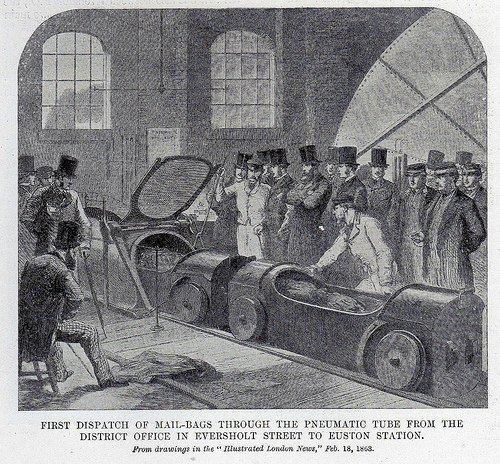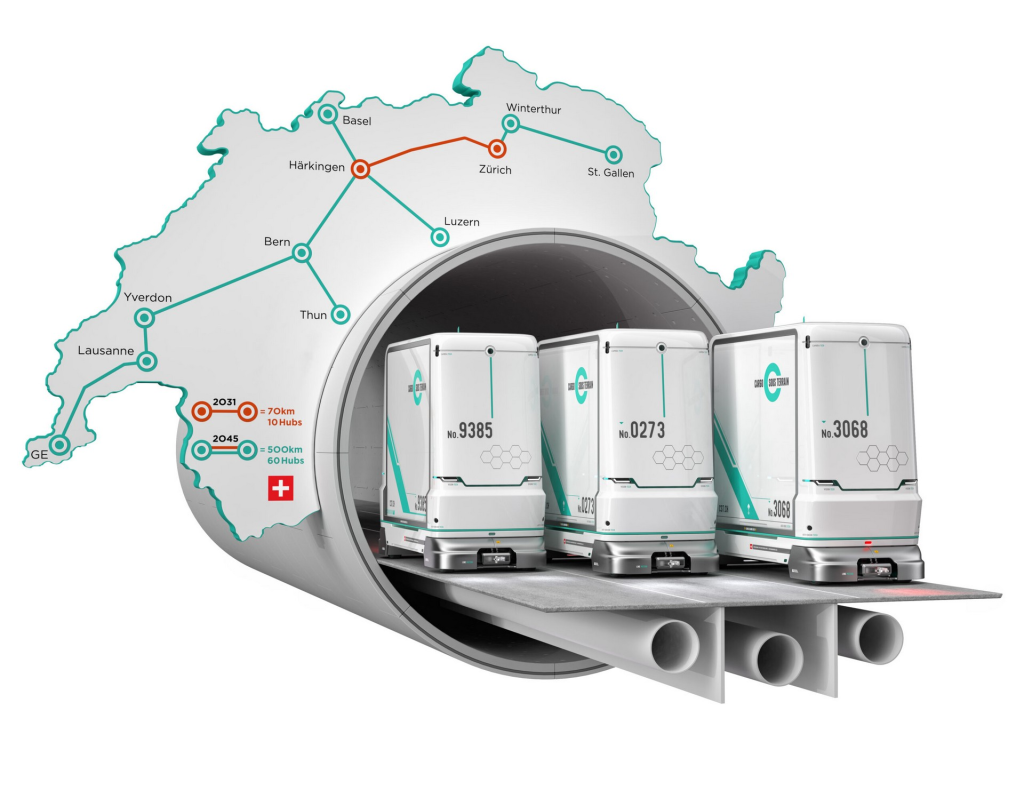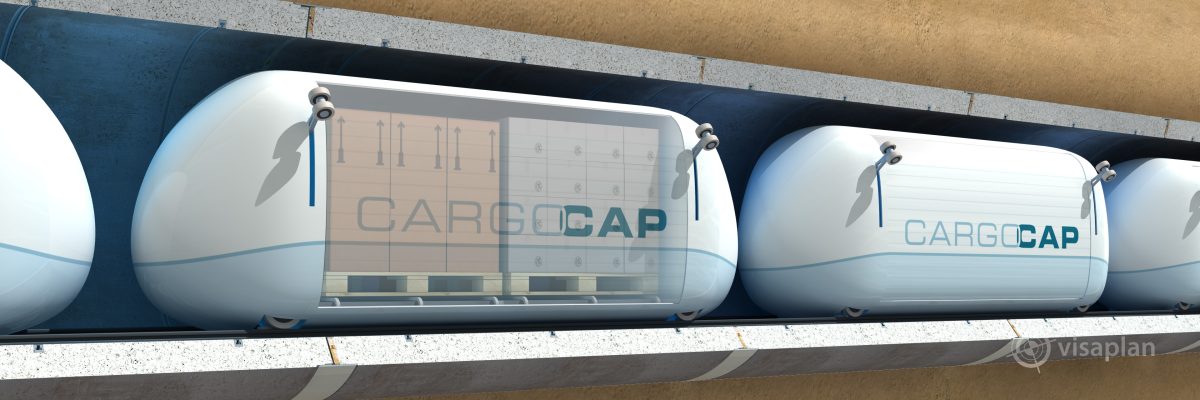CargoCap is an innovative system that seeks to reduce the amount of delivery truck traffic in our cities. Fully automated capsules travel through a tunnel system connecting major logistical destinations within cities.
In this article I will present this idea and try to give an outlook on its potential advantages and disadvantages.
The CargoCap System
The CargoCap system was developed at the University of Bochum, Germany, and is now promoted by the company CargoCap GmbH (Link, only in German).
The idea is to use a capsule – or “cap” for short – to transport goods underground. The caps can carry two or three europallets. They move automatically and do not need a driver.

The initiators of the system argue that the tunnels can be constructed very cheaply by using pipe driving techniques.

The easy way to build tunnels would make the system relatively cheap to build and the automated caps efficient to operate, the company promises.
But is this really so? I analyzed the system to get a first impression of whether it would be a viable solution to urban traffic problems.
Economic Viability
Building a completely new infrastructure system demands a lot of upfront investment. Planning must be done, permits must be obtained, and tunnels and stations must be built. The new capsules have to be developed and tested intensively. The same goes for the control system. All parts of the CargoCap system are completely new and will require a lot of research and development, even though PhD students at the University of Bochum have done some research.
This means that any company that wants to operate a CargoCap system will have to invest a lot of capital, and this means that the customers will eventually have to bear the capital costs. My guess is that this will make transportation with the CargoCap much more expensive compared to road transportation. After all, trucks and vans can use the existing infrastructure, and in most places for free.
This leads to the question, what incentives will customers have to use a CargoCap? One of them could be reliability.
Reliability
A potential advantage of this system is that it could be much more reliable than road transportation. The argument would be that the capsules would just move underneath the traffic jams. They would not be blocked or slowed down by road traffic. This factor would make the CargoCap particularly suitable for companies that rely on just-in-time delivery, such as car manufacturers.
For factories located within a city, like BMW’s Munich plant or Volkswagen’s Transparent Factory in Dresden, this could be a real advantage. Trucks coming from the highway could deliver their goods to a logistics hub on the outskirts of the city. There, the parts could be stored and then loaded onto a CargoCab that would go directly to the plant, perhaps even directly to the factory building where it is needed.

But such reliability is not automatic. After all, congestion can occur even underground. If just one cab got stuck, for whatever reason, it would block the entire tunnel for all the other cabs following it. Traffic would grind to a halt.
This was a design factor that ultimately doomed a very similar business venture some 150 years earlier: The London Pneumatic Despatch Company (see Wikipedia).

This problem could be mitigated by adding redundancy, i.e. adding more tunnels to cover the same distance. This drives up the initial investment cost significantly.
If a larger network is built in a city, this could provide the redundancy needed to increase reliability. But to really achieve this reliability, the operational plans need to take such congestion into account. For example, all blocked cabs must be able to reverse direction and then follow another route. The tunnel network must be expanded to include enough switches and junctions to allow the cabs to reach an alternate route.
The remaining tunnels must have enough capacity to handle the unusual extra traffic from the rerouted cabs.
And last but not least, there must be a way to retrieve the cab(s) that got stuck and caused the jam in the first place. This brings me to the question of maintenance.
How do you maintain a tiny tunnel network underground? To elaborate on my example of a CargoCap getting stuck, how do you get it out?
You may need a machine that can be brought in from an operations base. To get to the site of the accident, it has to travel through the tunnel system. Any remaining cabs that can still move need to be removed first and moved to an alternate route.
Then the maintenance vehicle can come and try to tow the cab away.
And I think this is a big problem because the tunnels are very narrow and there is not much space between the tunnel and the cab. So it would not be possible, for example, to lift a cab with a crane and put it on a rescue vehicle. There could even be cases where a cab is stuck in a wall after a crash, and I imagine that in such cases the only way to remove the cab would be to dismantle it.
This problem could be alleviated by making the tunnels larger. Subway tunnels have enough space to accommodate larger rescue equipment. However, this would make the tunnels much more expensive to build, which could further reduce the profitability of the system.
Another issue is the maintenance of the tunnel system. Every tunnel system needs access points for maintenance personnel. But where to put them? Often, the only open spaces in cities are the streets. This limits where the tunnel system can go in reality, because you cannot have too long stretches without maintenance access. But if you want to put the tunnels under the streets, that brings us to the next question.
Coexistence with Underground Infrastructure
The space under our streets is not free. In every modern city, we have sewers that run directly under the streets. Larger cities even have subway tunnels. Add to that cable shafts for electricity and telephone lines, and pipelines for district heating, and you can see that the underground is already very crowded.
Adding another network of tunnels would be like solving a very complex puzzle. This leads me to believe that this illustration provided by the company CargoCap is very optimistic:

I am not saying that this puzzle cannot be solved at all, but it would take a lot of planning and coordination with the authorities, as they are the only ones who have the plans of what runs underground.
Another factor that makes this system more expensive to build.
Who needs this System?
Coming back to the question of profitability. The more customers the system has, the lower the cost per customer and the more attractive the system becomes. As I wrote above, manufacturers could be interested in this system because it could be more reliable and faster than road transportation if the problems I mentioned could be solved.
Another customer base could be supermarkets. Every morning several trucks go from the distribution centers of the supermarket chains to the stores in the city. This would be an ideal situation where the CargoCap system could help, if it could be built cheaply enough to connect all the stores in a city. Of course, an additional type of cap would be needed to keep the goods cool during transport.
Similarly, parcel delivery services could set up a few CargoCab hubs throughout the city and deliver parcels from the hubs on the outskirts of the city. Then the parcels could be delivered from these city hubs, and since the distances are shorter, it could be done by bicycle, for example. This was also suggested by the company CargoCap:

But I ask myself: Will these applications be enough to pay for all the infrastructure? The amount of goods will still be relatively small compared to the capacity that the CargoCap system promises. Won’t it be cheaper for these potential customers to just use road transport?
Lessons from History
You may know that I like to draw lessons from the history of long forgotten transportation systems, like in this article. The CargoCap system reminds me of the only large-scale underground transportation system ever built: The Chicago Tunnel Company (see Wikipedia).

It served a similar purpose as the CargoCap system is trying to serve now: It connected businesses and buildings in Chicago. It operated for a few decades, but it was never profitable.
And its main cargo was coal, which its customers used to heat their buildings. Coal is a bulk commodity that can be moved very efficiently underground.
But eventually customers switched to natural gas for heating. With its main source of income gone, the Chicago Tunnel Company eventually went bankrupt because its remaining freight, such as mail, did not generate enough revenue to keep the company going.
Even those customers who still bought coal found it easier to have it delivered at street level than to use complex mechanisms to transport it from underground stations to their buildings.
This makes me wonder if the potential use cases I have identified so far would pay enough to keep a CargoCap system running or even make it profitable.
Outlook
I hope you enjoyed my thoughts on the concept of the CargoCap system. I just like to think about the ups and downs of transportation systems and what makes some successful while other ideas never see a large scale implementation.
Unfortunately, I may never know how the story of the CargoCap would have turned out and if the factors I see play a role in the actual design. Although the idea was proposed about 15 years ago, not a single project has been started or even built. And the last update of the homepage is also two years old now, which makes me wonder if the company is still working on promoting this concept.
But all is not lost. A very similar idea is now being pursued in Switzerland by the company Cargo Sous Terrain (Link). They are currently planning to build an underground network connecting the major cities.
They seem to have a lot of investors and are actively hiring, which gives the impression that they are serious about their plans.

And their concept seems much more viable to me because they are planning with a much larger tunnel diameter of 6m. This will make maintenance and disaster recovery much easier. However, many of the other challenges that I have identified will also apply to this new system, especially the question of economic viability.
I am very curious to see how this plays out, and if we really will see a second major underground transportation system after the Chicago Tunnel Company. And I am even more curious as to whether the system will be reliable and profitable.
The story of underground transportation systems is not over.

4 replies on “The CargoCap System – A Revolution in Underground Transportation?”
Hi Stephan,
Interesting write up. It’s indeed a costly proposition. Do you think reusing the existing infrastructure by making parts of it fully autonomous (self driving platforms as an abstraction layer to move cars, cargo and people) will work?
See video of the project http://www.carfax.today
Hello Christoph,
thanks for bringing this concept to my attention. I had never heard about it.
My first thoughts about it are: Isn’t this replicating self-driving cars? After all, the pods that Carfax proposes to employ need to be self-driving, so the challenges are the same as for autonomous cars.
So for cars that already drive autonomously, this system will not make any sense. It would make most sense for upgrading normal cars with some self-driving capabilities in city centers.
Another question that comes to mind is how cars will enter this system. If you park at home, maybe a pod could come pick you up. But how does it pick up all the other vehicles that enter the city coming from the outside? Can they pick up the cars while they area driving, or does one have to park on a certain parking spot and wait to be picked up? This could affect acceptance by the drivers.
And this system would require quite a lot of these pods to cover the surges in demand during the rush hour. The rest of the day, most pods will not be needed and need to be parked in some place.
Do you know who is behind this concept? The website did not give any information about it.
Cheers!
Stefan
Servus, Stefan!
You’ve raised some crucial questions for a better understanding of the Carfax concept. Here are my thoughts on them.
>>> Q: My first thoughts about it are: Isn’t this replicating self-driving cars?
> A: No, actually, it’s not. We’re all familiar with the images of traffic jams involving both traditional ICE cars and EVs. They are essentially the same, and autonomous driving cars don’t bring any significant improvements either. The primary focus of the Carfax concept is to make slight adjustments to the infrastructure and substantially increase its capacity (measured in people per hour) with relatively small investments. So, it’s more of a city infrastructure concept than a self-driving car pod.
>>> Q: After all, the pods that Carfax proposes to employ need to be self-driving, so the challenges are the same as for autonomous cars.
> A: Yes and no. Consider the challenges faced by self-driving algorithms when navigating through “chaotic” situations, attempting to predict the behavior of other human drivers. The Carfax system assumes certain areas are designated for Carfax pods only. I understand that convincing city authorities to accept this idea may not be realistic, but some futuristic project cities could experiment with it, and if the concept proves successful, it might pave the way for other cities to adopt a similar approach. This approach could potentially enable municipalities to manage traffic more efficiently and cost-effectively than, for example, building expensive multilevel intersections.
Having a controlled operating environment is key to unlocking a range of possibilities: relocating sensors and primary algorithms to infrastructure operators, producing very cost-effective pods, eliminating most existing traffic rules designed for human drivers, such as traffic lights and lanes, and grouping multiple vehicles into “pod trains” that move continuously through a city.
>>> Q: So for cars that already drive autonomously, this system will not make any sense. It would make most sense for upgrading normal cars with some self-driving capabilities in city centers.
> A: First and foremost, it depends on the level of autonomous driving we’re comparing with the Carfax system. Carfax is designed to be at level 5, and even when compared to a level 5 car, Carfax pods offer advantages such as faster travel (e.g., no traffic lights, merging faster into traffic) within precisely predictable time intervals, and they also provide parking options. “Halo-ing” could also be a possibility.
>>> Q: Another question that comes to mind is how cars will enter this system. If you park at home, maybe a pod could come pick you up. But how does it pick up all the other vehicles that enter the city coming from the outside? Can they pick up the cars while they area driving, or does one have to park on a certain parking spot and wait to be picked up? This could affect acceptance by the drivers.
> A: The entry and exit points are crucial for the user experience. The Carfax system is designed to serve predefined areas. Picking up from home could be an option, but it presents challenges, same as self-driving cars navigating unfamiliar streets with human drivers. Entry and exit points could resemble multi-lane stoplights, where a car entering the city (served areas) stops at a waiting pod, and the pod takes it away. As for how the pod knows where to go, the simple answer is through a mobile app. We certainly don’t want to enter an address daily when heading to work, so the user experience needs to be seamless in this regard.
>>> Q: And this system would require quite a lot of these pods to cover the surges in demand during the rush hour. The rest of the day, most pods will not be needed and need to be parked in some place.
> A: That is a valid concern. The principle to improve the current situation applies here. How many trips does a vehicle typically make within a city center per day? Probably an average of 2-3. One pod could serve dozens of trips. Additionally, consider that pods are much smaller than regular cars, and they can autonomously stack themselves in a small parking area for charging.
If the Carfax concept takes off, the pods would essentially serve as taxis for people and goods within public “seater boxes” rather than moving around heavy cars. Nevertheless, every new system requires a transition phase. For some reason, drivers have a strong attachment to their cars, and changing this mindset becomes easier by keeping the cars and offering a transportation alternative which ist significantly cheaper (the cost per kilometer must be lower than individual vehicles), faster (no traffic lights), and fully autonomous (allowing drivers to utilize travel time for work or leisure).
>>> Q: Do you know who is behind this concept? The website did not give any information about it.
> A: I can provide you with the contact details.
[…] Swiss company Cargo sous terrain, about which I wrote back in July, announced that they have started test drillings (see press release). These drills will help […]